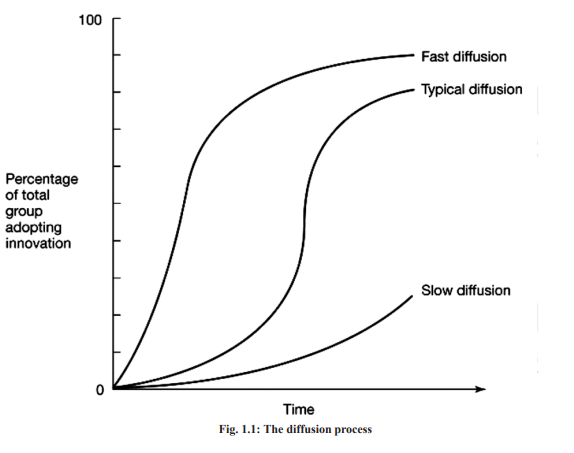What is meant by diffusion process? Describe the elements in the diffusion of innovations.
Diffusion of Innovations is a theory that seeks to explain how, why, and at what
rate new developmental ideas, practices and technology spread through the social
system. The concept was first studied by the French sociologist Gabriel Tarde
(1890) and by German and Austrian anthropologists such as Friedrich Ratzel
and Leo Frobenius. Its basic epidemiological or internal-influence form was
formulated by H. Earl Pemberton, who provided examples of institutional
diffusion such as postage stamps and compulsory school laws. In 1962 Everett
Rogers, a professor of rural sociology published ‘Diffusion of Innovations’. In this
book, Rogers synthesized research from over 508 diffusion studies and produced
a theory for the adoption of innovations among individuals and organizations.
Diffusion Process
Diffusion of innovations refers to the spread of the developmental innovations
through a population, and is simply the result of a host of individual adoption
decisions (Fig. 1.1). If individual adoption decisions are, to an extent, predictable,
then the larger diffusion process is also predictable. It follows a pattern, and that
element of predictability has substantial implications. Therefore as per Rogers,
diffusion process is “the spread of a new idea from its source of invention or
creation to its ultimate use of adopters”. The diffusion of innovations is essentially
a social process in which subjectively perceived information about a new idea is
communicated.

ELEMENTS IN THE DIFFUSION OF INNOVATIONS
Innovation
An innovation is an idea, practice, or object that is perceived as new or an
improvement over the existing one by the individual or members of a social
system. If the idea seems new, it is an innovation. As the innovation may represent
a slight modification of, or a significant departure from, the existing idea or
practice. The ‘idea’ constitutes the central element of an innovation which often
manifests itself in a material or behavioural form.
Examples for Material Form : improved agricultural implements, high- yielding
and disease resistant seeds, bio-fertilizers, pesticides and herbicides.
Examples for Behavioral Form: Improved cultural practices.
An innovation do not diffuse at the same rate. An innovation which represents
only a slight modification of an existing idea or practice will obviously diffuse at
a faster rate than the one which represents a significant departure from it. Some
of the important attributes of an innovation which influence the rate of adoption
are:
i) Relative advantage
ii) Compatibility
iii) Complexity
iv) Trialability
v) Observability
Communication Channels
A communication channel is the means by which messages get from one
individual to another.
Examples: Mass media channels, Interpersonal channels.
Mass media channels are all those means of transmitting messages that involve
a mass medium such as radio, television, newspapers and so on, which enable a
source of one or a few individuals to reach an audience of many.
Interpersonal channels involve a face-to-face exchange between two or more
individuals. Interpersonal channels are more effective in persuading an individual
to accept a new idea, especially if the interpersonal channel links two or more
individuals who are similar in socio-economic status, and education.
Time
Time which is the is the 3rd element in diffusion process is involved in:
i) Innovation – decision process
ii) Innovativeness, and
iii) Rate of adoption of innovation
Social System
A social system is defined as a set of interrelated units that are engaged in joint
problem solving to accomplish a common goal. The members or units can be
individuals, informal groups, organizations, or sub systems. The sharing of
common objective binds the system together.
Diffusion occurs within a social system. The social structure of the system
influence how and what information is disseminated. Knowledge of social
structure is important to consider while studying diffusion.
Example 1 : A village as a social system is made up of a variety of individuals
and groups with distinctive roles, norms and goals all of which, at least in ideal
terms, functionally relate to each other to attain its major goals and objectives.
The structure of a social system constitutes a set of boundaries within which
innovation diffuse. The differences in the adoption of innovations at the village
level can often to explained in terms of their differences in structural
characteristics. The degree to which a village is structurally homogeneous or
heterogeneous, unitary or highly stratified, affects the rate of diffusion of
innovations within its boundaries. The information can be distributed through
formal (Government) and informed communication structures (peers, groups
etc.).
Example 2 : In a village ‘A’ the rate of adoption of an innovation was 57 percent
and only 26 percent in village B. This indicates that social and communication
structures of these two villages are quite different ‘regarding the diffusion of
innovation, even though these innovations had promoted equally in both villages
by Government agency. We can predict that in village ‘A’ the friends, neighbours
are more likely to encouraging others to adopt since they themselves have adopted,
and the village leaders in village ‘A’ are specially committed to adoption of an
innovation, while in village ‘B’ they are not. This example shows how a system’s
structure can effect the diffusion and adoption of innovations, over and above
the effect of such variables as the individual characteristics of the members of
the system. Also individual innovativeness is affected by individuals’
characteristics and by the nature of the social system in which individuals are
members.





